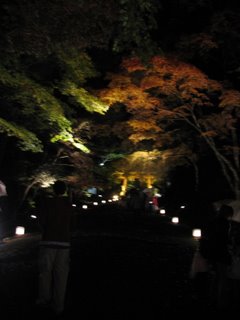Nighttime Momiji watching (Kouyou 紅葉)
Here is a delayed introduction to watching leaves falling in the dark. I previously mentioned (Friday, November 10, 2006) the hobby of watching Sakura (桜=cherry blossoms) in the spring and Momiji (紅葉=Japanese Maples) and Icho (Ginko) in the autumn when their leaves are vibrantly exploding with color. The colors show well in contrast too. Because this year was much warmer than last, some of the leaves are still green whereas others are progressing into deeper crimsons and oranges. As you can hopefully see in the photos, the experience of being surrounding by Momiji trees in various stages of brilliant wintery decay is astounding. I was just so giddy I couldn't contain myself. Temples and shrines all over Japan set up nighttime viewing lights so that families and friends can visit together after school or work.
Katie, our friend Carmen, and I were invited by one of Katie's coworkers (Hirakawa-sensei) to join her family for dinner and Kouyou (leaf-watching). The first photo is Katie's teacher and daughter with us in front of the soba shop where we ate. The soba (buckwheat noodles) was absolutely amazing, and we could watch the soba master (そば屋さん) hand-making everything we were about to eat. When preparing the soba he had two foot long sheets of dough that he would rapidly slice into shoestrings with the most massive knife I've ever seen in a kitchen (it looked like a butcher's knife that was literally three feet long––I'll bet he doesn't receive any complaints). This soba shop has been owned by one family for several hundred years, and they used to serve monks at Enrakuji Temple atop the nearest mountain (比叡山=Hiei-san). One of the recent emperors of Japan claimed the soba shop to be a site of National Heritage. I dare you to try it and say it it doesn't taste as good as it did 500 years ago!
It's really special to have teachers like Hirakawa-sensei and families who want to share special moments of their daily lives with us. This kind of invitation gives foreigners a feeling of home––which is hard to do––and sharing in traditions such as Kouyou and old, old soba was one fun way to do it.
The final picture is one of Taiko (太鼓=traditional Japanese drums) in action. Elementary, Junior, and High School students preformed several "songs", I'm lacking a better word, at one of the main temples we visited (I'm also lacking the name). Hearing the thumping rhythm as we walked through the canopy of fall colors added to the illusion of being in a pre-camera age. I could imagine the lights were candle-lit lanterns and electricity was a dream that could not contend with the human energy hammering between mallet and skin. 





0 Comments:
Post a Comment
<< Home